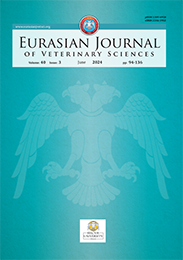| 2019, Cilt 35, Sayı 2, Sayfa(lar) 109-113 | |
| [ Özet ] [ PDF ] [ Benzer Makaleler ] [ Yazara E-Posta ] [ Editöre E-Posta ] | |
| A case of perirenal pseudocyst in a cat | |
| Erdem Gülersoy1, Mahmut Ok1, Muhammed Mustafa Kapar1, Ayşe Çelebi2 | |
| 1Selçuk Üniversitesi Veteriner Fakültesi İç Hastalıkları Anabilim Dalı, 42250, Konya, Türkiye 2Selçuk Üniversitesi Veteriner Fakültesi Patoloji Anabilim Dalı, 42250, Konya, Türkiye |
|
| Keywords: Cat, perirenal pseudocyst, sepsis, ultrasonography, necropsy | |
| Abstract | |
The material of this case was 1-year-old male cat with complaints
of loss of appetite, stagnation, vomiting, paresis in the
back extremities, reduction of urine output and icterus which
admitted to the Animal Hospital of Faculty of Veterinary Medicine
of Selcuk University. Perirenal pseudocyst, hepatic
lipidosis and sepsis were determined by clinical, laboratory,
histopathological and ultrasonographic examinations.
Physical findings revealed hypothermia (35.8 Cº), leukopenia
(4.23 m / mm3), tachypnea and bradycardia (64 beats/
min). Perirenal pseudocyst which determined by ultrasound
examination was confirmed by necropsy. 0.9% NaCl and 5%
dextrose solution, vitamin and amino acid, ceftriaxone 25 mg
/ kg, furosemide 1 mg / kg, n-acetylcysteine 70 mg / kg, ursodeoxycholic
acid 15 mg / kg, dobutamine 1.25 andg / kg /
min were used for protecting kidney function and for sepsis
and hepatic lipidosis. Despite one week of treatment, the patient
did not recover and died. In this case report, clinical,
laboratory, ultrasonographic and necropsy findings of the
iranian cat with sepsis associated with perirenal pseudocyst
are presented. In conclusion, it was concluded that perirenal
pseudocystic is genetically predisposed to persian cats and
ultrasonographic examination is an important diagnostic
method in the diagnosis of perirenal pseudocyst. |
|
| [ Başa Dön ] [ Özet ] [ PDF ] [ Benzer Makaleler ] [ Yazara E-Posta ] [ Editöre E-Posta ] | |





